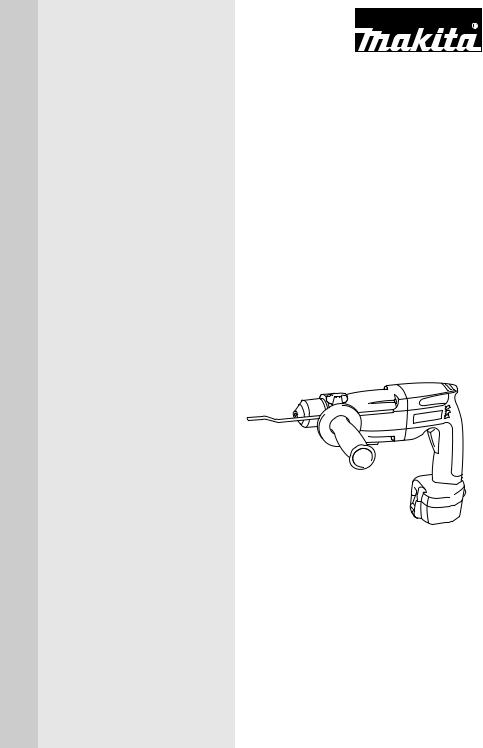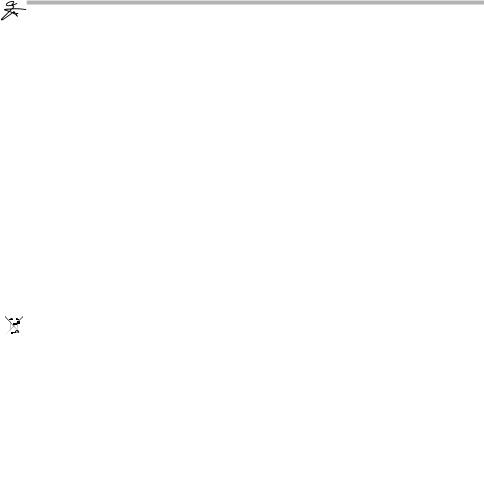Makita HR160DWAHR160D, DC24WA Manual

ENGLISH
Cordless Rotary
Hammer
MODEL HR160D
004204
I N S T R U C T I O N M A N U A L
 WARNING:
WARNING:
For your personal safety, READ and UNDERSTAND before using. SAVE THESE INSTRUCTIONS FOR FUTURE REFERENCE.

SPECIFICATIONS
|
Model |
HR160D |
|
|
|
|
|
|
|
Concrete |
16 mm |
|
|
|
|
Capacities |
|
Steel |
13 mm |
|
|
|
|
|
|
Wood |
20 mm |
|
|
|
|
|
No load speed (min-1) |
0 - 950 |
|
|
Blows per minute |
0 - 3,600 |
|
|
|
|
|
|
Overall length |
296 mm |
|
|
|
|
|
|
Net weight |
2.5 kg |
|
|
|
|
|
|
Rated voltage |
D.C.12 V |
|
|
|
|
|
•Due to our continuing programme of research and development, the specifications herein are subject to change without notice.
•Note: Specifications may differ from country to country.
END001-1
Symbols
The following show the symbols used for the equipment. Be sure that you understand their meaning before use.
..................Only for EU countries
Do not dispose of electric equipment together with household waste material!
In observance of European Directive 2002/96/EC on waste electric and electronic equipment and its implementation in accordance with national law, electric equipment that have reached the end of their life must be collected separately and returned to an environmentally compatible recycling facility.
Intended use
The tool is intended for hammer drilling and drilling in brick, concrete and stone as well as for chiselling work.
It is also suitable for drilling without impact in wood, metal, ceramic and plastic.
For European countries only Noise and Vibration
The typical A-weighted sound pressure level is 84 dB (A). Uncertainty is 3 dB(A).
The noise level under working may exceed 85 dB (A).
– Wear ear protection. –
The typical weighted root mean square acceleration value is 8 m/s2.
These values have been obtained according to EN60745.
EC-DECLARATION OF CONFORMITY
We declare under our sole responsibility that this product is in compliance with the following standards of standardized documents;
EN60745, EN55014 in accordance with Council Directives, 89/336/EEC, 98/37/EC.
Yasuhiko Kanzaki CE2005
Director
MAKITA INTERNATIONAL EUROPE LTD.
Michigan Drive, Tongwell, Milton Keynes, Bucks MK15 8JD, ENGLAND
Responsible manufacturer:
Makita Corporation Anjo Aichi Japan
2

GENERAL SAFETY RULES |
GEA002-3 |
 WARNING:
WARNING:
Read all instructions. Failure to follow all instructions listed below may result in electric shock, fire and/or serious injury. The term “power tool” in all of the warnings listed below refers to your mains-operated (corded) power tool or batteryoperated (cordless) power tool.
SAVE THESE INSTRUCTIONS
Work area safety
1.Keep work area clean and well lit. Cluttered and dark areas invite accidents.
2.Do not operate power tools in explosive atmospheres, such as in the presence of flammable liquids, gases or dust. Power tools create sparks which may ignite the dust or fumes.
3.Keep children and bystanders away while operating a power tool. Distractions can cause you to lose control.
Electrical safety
4.Power tool plugs must match the outlet. Never modify the plug in any way. Do not use any adapter plugs with earthed (grounded) power tools. Unmodified plugs and matching outlets will reduce risk of electric shock.
5.Avoid body contact with earthed or grounded surfaces such as pipes, radiators, ranges and refrigerators. There is an increased risk of electric shock if your body is earthed or grounded.
6.Do not expose power tools to rain or wet conditions. Water entering a power tool will increase the risk of electric shock.
7.Do not abuse the cord. Never use the cord for carrying, pulling or unplugging the power tool. Keep cord away from heat, oil, sharp edges or moving parts. Damaged or entangled cords increase the risk of electric shock.
8.When operating a power tool outdoors, use an extension cord suitable for outdoor use. Use of a cord suitable for outdoor use reduces the risk of electric shock.
Personal safety
9.Stay alert, watch what you are doing and use common sense when operating a power tool. Do not use a power tool while you are tired or under the influence of drugs, alcohol or medication. A moment of inattention while operating power tools may result in serious personal injury.
10.Use safety equipment. Always wear eye protection. Safety equipment such as dust mask, non-skid safety shoes, hard hat, or hearing protection used
for appropriate conditions will reduce personal injuries.
11.Avoid accidental starting. Ensure the switch is in the off-position before plugging in. Carrying power tools with your finger on the switch or plugging in power tools that have the switch on invites accidents.
12.Remove any adjusting key or wrench before turning the power tool on. A wrench or a key left attached to a rotating part of the power tool may result in personal injury.
13.Do not overreach. Keep proper footing and balance at all times. This enables better control of the power tool in unexpected situations.
14.Dress properly. Do not wear loose clothing or jewellery. Keep your hair, clothing, and gloves away from moving parts. Loose clothes, jewellery or long hair can be caught in moving parts.
15.If devices are provided for the connection of dust extraction and collection facilities, ensure these are connected and properly used. Use of these devices can reduce dust-related hazards.
Power tool use and care
16.Do not force the power tool. Use the correct power tool for your application. The correct power tool will do the job better and safer at the rate for which it was designed.
17.Do not use the power tool if the switch does not turn it on and off. Any power tool that cannot be controlled with the switch is dangerous and must be repaired.
18.Disconnect the plug from the power source and/ or the battery pack from the power tool before making any adjustments, changing accessories, or storing power tools. Such preventive safety measures reduce the risk of starting the power tool accidentally.
19.Store idle power tools out of the reach of children and do not allow persons unfamiliar with the power tool or these instructions to operate the power tool. Power tools are dangerous in the hands of untrained users.
3

20.Maintain power tools. Check for misalignment or binding of moving parts, breakage of parts and any other condition that may affect the power tools operation. If damaged, have the power tool repaired before use. Many accidents are caused by poorly maintained power tools.
21.Keep cutting tools sharp and clean. Properly maintained cutting tools with sharp cutting edges are less likely to bind and are easier to control.
22.Use the power tool, accessories and tool bits etc. in accordance with these instructions and in the manner intended for the particular type of power tool, taking into account the working conditions and the work to be performed. Use of the power tool for operations different from those intended could result in a hazardous situation.
Battery tool use and care
23.Ensure the switch is in the off position before inserting battery pack. Inserting the battery pack into power tools that have the switch on invites accidents.
24.Recharge only with the charger specified by the manufacturer. A charger that is suitable for one type of battery pack may create a risk of fire when used with another battery pack.
25.Use power tools only with specifically designated battery packs. Use of any other battery packs may create a risk of injury and fire.
26.When battery pack is not in use, keep it away from other metal objects like paper clips, coins, keys, nails, screws, or other small metal objects that can make a connection from one terminal to another. Shorting the battery terminals together may cause burns or a fire.
27.Under abusive conditions, liquid may be ejected from the battery, avoid contact. If contact accidentally occurs, flush with water. If liquid contacts eyes, additionally seek medical help. Liquid ejected from the battery may cause irritation or burns.
Service
28.Have your power tool serviced by a qualified repair person using only identical replacement parts. This will ensure that the safety of the power tool is maintained.
29.Follow instruction for lubricating and changing accessories.
30.Keep handles dry, clean and free from oil and grease.
SPECIFIC SAFETY RULES |
GEB007-2 |
DO NOT let comfort or familiarity with product (gained from repeated use) replace strict adherence to rotary hammer safety rules. If you use this tool unsafely or incorrectly, you can suffer serious personal injury.
1.Wear ear protectors. Exposure to noise can cause hearing loss.
2.Use auxiliary handles supplied with the tool.
Loss of control can cause personal injury.
3.Hold power tools by insulated gripping surfaces when performing an operation where the cutting tool may contact hidden wiring or its own cord.
Contact with a “live” wire will make exposed metal parts of the tool “live” and shock the operator.
4.Wear a hard hat (safety helmet), safety glasses and/or face shield. Ordinary eye or sun glasses are NOT safety glasses. It is also highly recommended that you wear a dust mask and thickly padded gloves.
5.Be sure the bit is secured in place before operation.
6.Under normal operation, the tool is designed to produce vibration. The screws can come loose easily, causing a breakdown or accident. Check tightness of screws carefully before operation.
7.In cold weather or when the tool has not been used for a long time, let the tool warm up for a
while by operating it under no load. This will loosen up the lubrication. Without proper warmup, hammering operation is difficult.
8.Always be sure you have a firm footing.
Be sure no one is below when using the tool in high locations.
9.Hold the tool firmly with both hands.
10.Keep hands away from moving parts.
11.Do not leave the tool running. Operate the tool only when hand-held.
12.Do not point the tool at any one in the area when operating. The bit could fly out and injure someone seriously.
13.Do not touch the bit or parts close to the bit immediately after operation; they may be extremely hot and could burn your skin.
14.Some material contains chemicals which may be toxic. Take caution to prevent dust inhalation and skin contact. Follow material supplier safety data.
4
